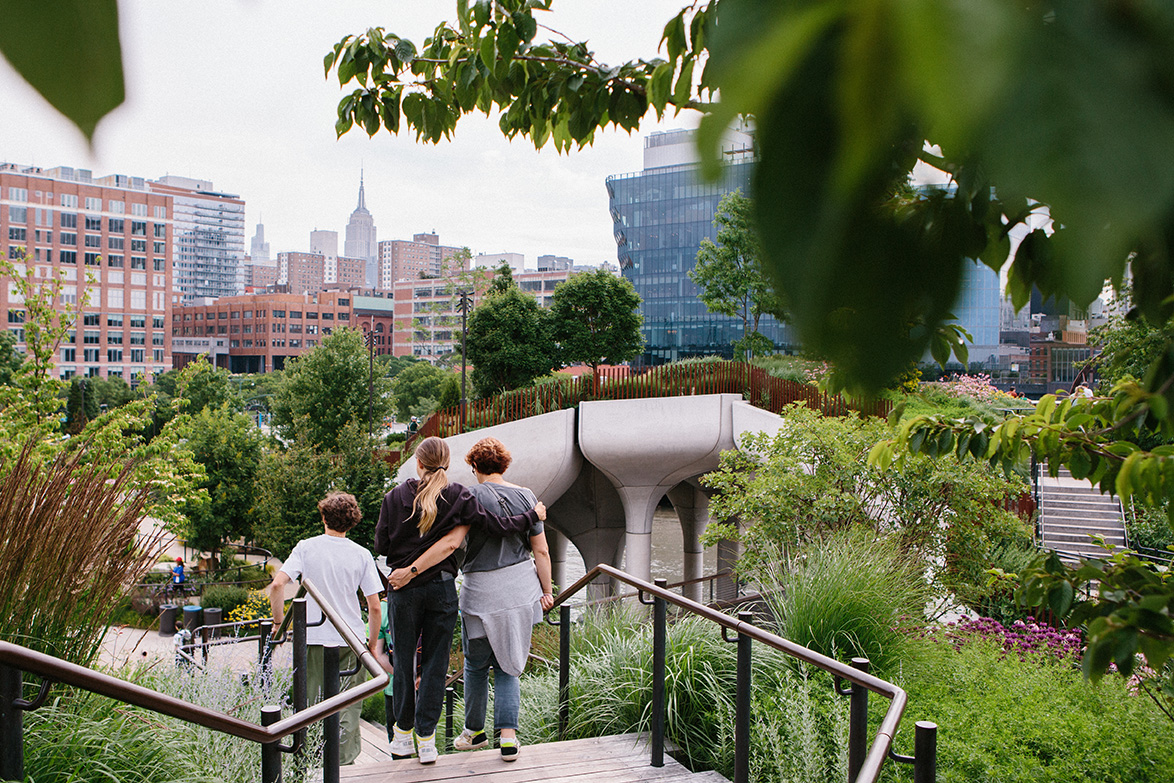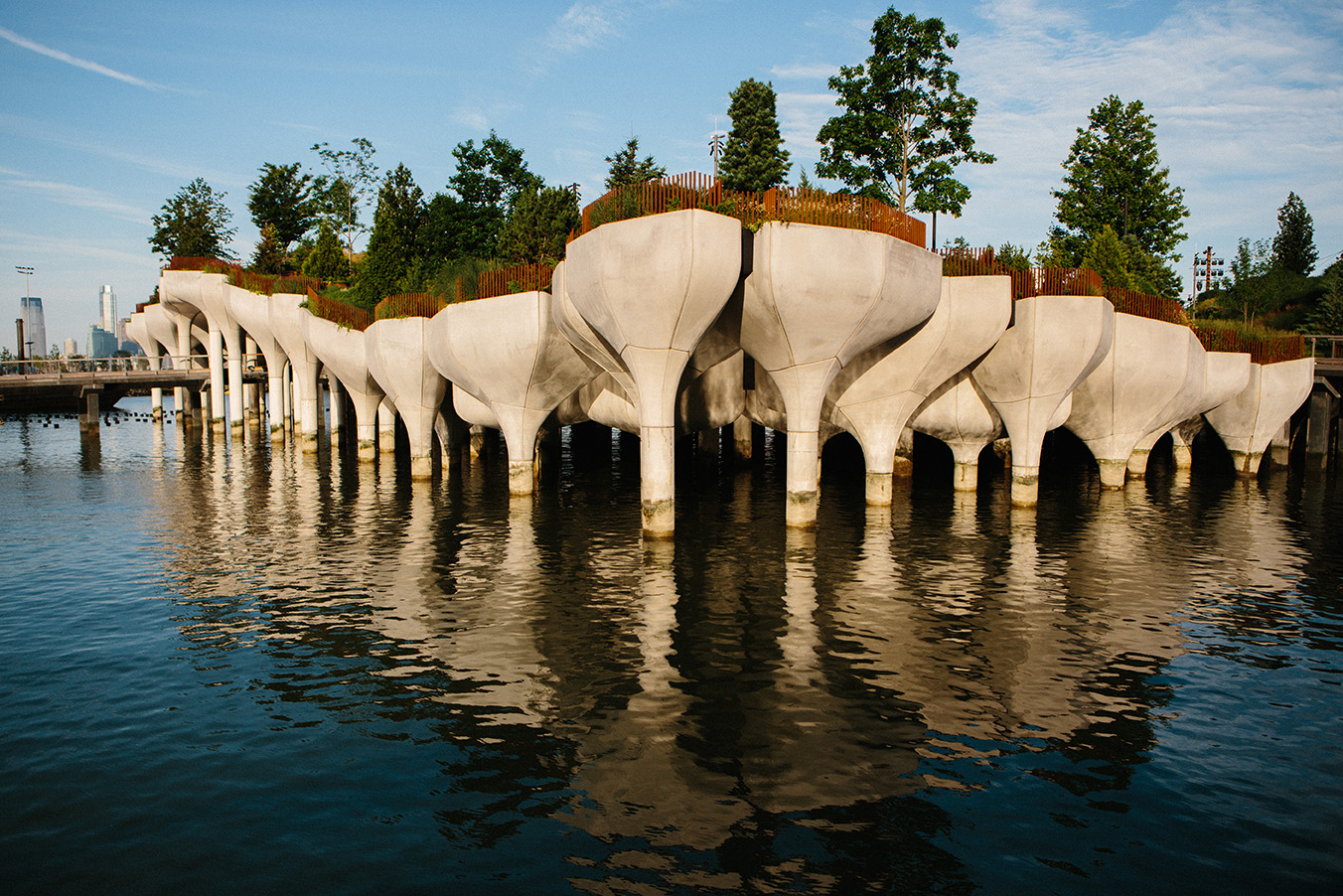On May 21, 2021, in the midst of the dark days of the coronavirus pandemic, a new park opened in New York City. Little Island is unlike any other green space in the city: It’s suspended over the Hudson River like, well, a little island.
Visitors hugged each other as they entered the park, recognizing the momentous occasion of an addition to the Manhattan coastline. And it also provided a relatively safe, open space for people to reconnect, something desperately wanted and needed at the time. It was as if traveling to the park not only instantly transported one out of the city, but away from the trauma of the pandemic.

More than 100 68-ton concrete pilings, referred to as “pots” or “tulips” hold up a 2.4 acre park hovering 15 feet over the Hudson. The tulips are anchored by piling “stems” that are submerged up to 200 feet below on the Hudson floor. Visitors can choose one of two walkways connecting to Manhattan to enter or exit the park. Walking around the island, the flora and fauna on the island itself change not just with each season, but even within each month. A green field might become lavender one month, and then change to white the next. Thus, one can visit multiple times and never see the same area in the same way in every visit.
Celine Armstrong describes it like this: “In every turn, your experience changes.”
Armstrong would play a creative and critical role in the creation of this addition to the city. However, in 2012, when the design of Little Island was being worked out, she was finishing up a master’s degree at Columbia University, and she was completely unaware of the unfolding project that would be the highlight of her career and consume the next seven years of her life. What she did know at the time was that she wanted to make a difference in New York City, something she had set her sights on from her earliest memories.
Water changes things
Growing up on a 120-acre farm in Harrison, Missouri, Armstrong was one of five children of a geotechnical engineer father who owned his own company planning and designing foundations before building began. All the children were expected to help out on the farm. By the age of 12, Armstrong could operate her dad’s bulldozer, and would spend hours after school bottle feeding the lambs. Her dad impressed upon her a love for the land through their farm and through his business.

“I understood how important it was to be a good steward of the land and how it impacted the environment,” she said during a conversation in February. “I knew the damage erosion could cause. I witnessed what happens to land when it’s misused. My dad helped me recognize that.”
And although she grew up in a landlocked state, tributaries from the nearby Great River ran through the farm, and Armstrong spent a lot of time playing in the streams. Water became a passion for Armstrong: “I’ve always had an interest in water and how it changed landscapes. I grew up respecting water. I mean, water always wins. I experienced that firsthand as we navigated the water that ran through our farm.”
Interested in how the combination of land, nature, and architecture affects people’s outlook and psyche, Armstrong was especially riveted in college by studies of children growing up in urban housing projects. “Did you know that if a child can see a tree from their window in a housing project, they have a stronger chance of doing well than if they don’t see one?”
Armstrong jumped at the chance to volunteer at a home that was being built on an episode in the series Extreme Home Makeover in Wichita. And she helped with the landscaping.
“That experience really moved me,” she said. “It combined my desire to help those in need with my love of creating an aesthetically pleasing property. The end result of that endeavor was that a deserving family could thrive with a beautiful landscape they could enjoy for the rest of their lives.” The importance of environments and their impact on people helped to shape Armstrong’s purpose and desire to create surroundings that are a source of happiness and well-being.”
In 2011, Celine moved to New York City, excited to see if she could make a difference in the physical landscape that almost nine million people call home. As she explored options, she was committed to a few ideals: “I wanted to play a significant female role in the industry, as I grew up knowing very few women landscape architects,” she said. Just as important, she wanted to make her mark among the disadvantaged of her newly adopted home. “The wealthier neighborhoods habitually have far nicer parks, open spaces, and spots that connect its denizens to nature more effectively than less affluent districts. I wanted to make a difference in disadvantaged neighborhoods.”






This story is from Common Good issue 09.